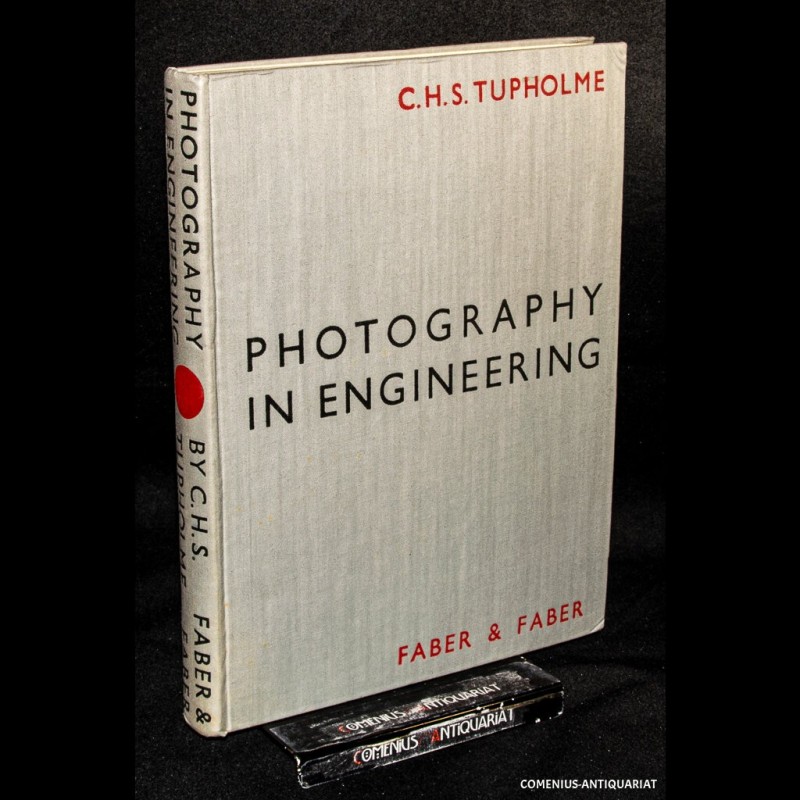Tupholme, C.H.S.,
Photography in Engineering. London: Faber and Faber et al, 1945. xv, 276 Seiten mit Abbildungen und Register. Leinen. Grossoktav. 244 x 185 mm.
* Ecken leicht bestossen.
Bestell-Nr.158384
Tupholme |
Technik |
Photographie |
Fotografie
Foreword
Photography in the engineering industries has progressed a very long way from the time when it was confined almost entirely to a picture of the firm's latest product, with a self-conscious foreman alongside to give scale and a creased white sheet to shut out the rest of the assembly shop. To-day, the camera in one of its many forms is one of the most accurate and reliable instruments available for the control of production, from the time the design is first put on paper until the finished article is offered for sale. To-day the camera in one form is doing more rapidly and more accurately what the draughtsman did yesterday. In another form, the camera provides rapid and irrefut-able evidence of the quality of the raw materials used, and yields vital data upon which the control of processes is based. In one of its several high-speed designs, the camera slows down the most rapid motion, enabling faults in fast-moving machinery to be traced. In conjunction with the x-ray and gamma-ray it reveals hidden but vital de-fects. X-ray diffraction analysis saves the time of both chemist and metallurgist in determining, among other things, the composition of materials and the surface con-dition of metals. Infra-red photography uncovers structures invisible to the ordinary photographic emulsion. And finally the eine camera will instruct, record, and demonstrate. This is a very cursory summary of what the camera is doing for engineers, and, while there is no shortage of literature on the many applications of photography in the engineering and allied industries, much of it is scattered in the technical press or in textbooks. An attempt has therefore been made here to bring the best of this material together and to present in a convenient form those photographic techniques which have proved of value in assisting the engineer in one of the many branches of his work, or which suggest similar uses in his craft. No attempt has been made to cover more than a few specific applications under each of the eight chapters into which the book is divided, nor would this be possible in a volume of this size. But each application has been selected because it is typical of many and, with slight variations in technique, which will readily suggest themselves, can be used for many similar purposes. It would also be quite impossible to give details of the very wide range of photographic equipment and materials available for the engineer : a few types only have been described as representative of their class. The book in fact does not pretend to be more than a summary of what is now being done with photography and, still more important, what could be done in the future; but ample references are given in the text, and a bibliography is printed at the end of each chapter for those who wish to investigate more fully any of the techniques described. It is exceedingly difficult to divide subject matter of this kind into water-tight com-partments, and the chapters must to a certain extent overlap, but the index has been made comprehensive in the hope that it will be of real assistance. In compiling this work I have had the willing assistance of many very busy people, to whom any credit for the volume is really due. I am particularly indebted to the editors of the journals mentioned in the text for permitting me to quote from their pages, and I have had invaluable advice and help from Kodak, Ltd., Ilford, Ltd., Adam Hilger, Ltd., Austin Edwards, Ltd. (makers of 'Ensign' photographic materials), Mr. H. P. Rooksby, B.Sc., F.Inst.P., of the Research Laboratories of the General Elec-tric Company, Ltd., the Editor of the Journal of Scientific Instruments, Mr. Wallace Harvey, F.R.P.S., Mr. G. R. Gribbin of the Victor X-ray Corporation, Ltd., Mr. E. J. Tunnicliffe of Siemens-Schuckert (Great Britain), Ltd., Mr. J. Ferdinand Kayser, Assoc.Met., of Gillette Industries, Ltd., Dr. Harold Edgerton of the Massachusetts Institute of Technology, Rotol Ltd., High Duty Alloys, Ltd., Westinghouse Electric and Manufacturing Company, the Tin Research Institute, the British Cotton Industry Research Association, the Ford Motor Company, Ltd., the General Electric Company (U.S.A.), the Glenn L. Martin Company, the Lockheed Aircraft Corporation, the General Radio Company, and the Radio Corporation of America.
Contents
FOREWORD page v
l. PHOTOGRAPHY OF DRAWINGS AND DOCUMENTS 1
2. PHOTOGRAPHY IN THE LABORATORY 40
3. HIGH-SPEED PHOTOGRAPHY 99
4. RADIOGRAPHY 132
5. X-RAY AND ELECTRON DIFFRACTION AND MICRORADIOGRAPHY 186
6. PROCESSING AND STORING X-RAY MATERIAL 244
7. INFRA-RED PHOTOGRAPHY 257
8. INSTRUCTIONAL MOTION PICTURES 262
INDEX 269






 Privacy
Privacy
 Shipping Costs
Shipping Costs
 Google Mail
Google Mail
